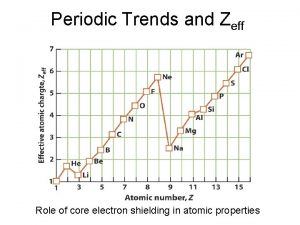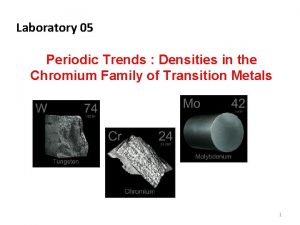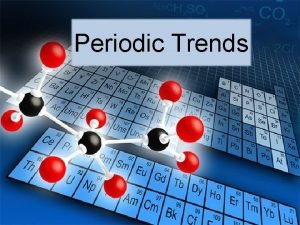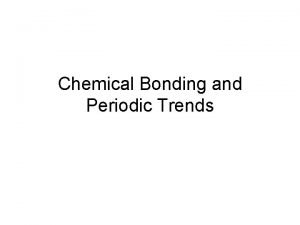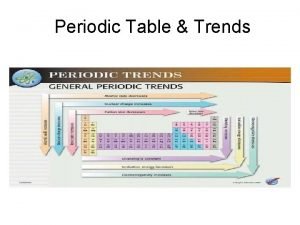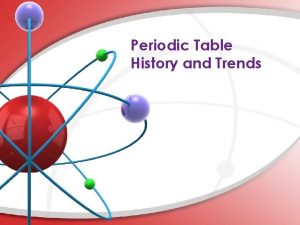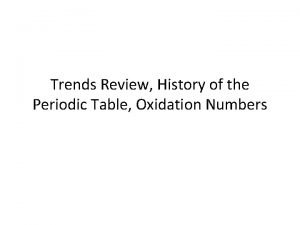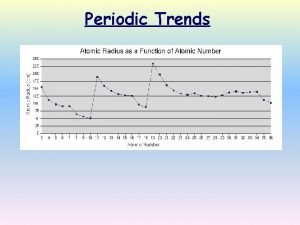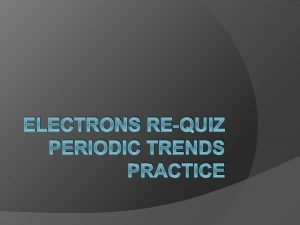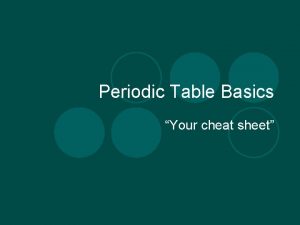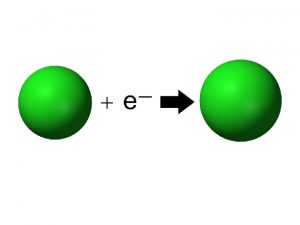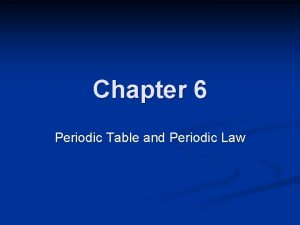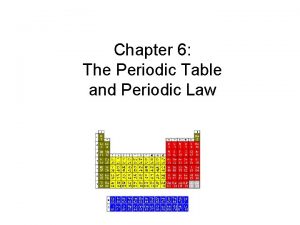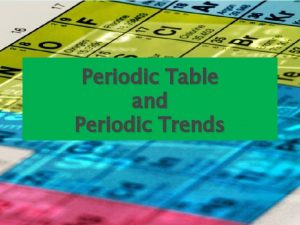Periodic trends Gradual changes or Large jumps Trends





































- Slides: 37

Periodic trends Gradual changes -> or Large jumps

Trends • The Periodic Table is arranged so that predictions can be made about the elements’ chemical behavior.

Periods and Group • Period – horizontal row on P. T. • Group – vertical column P. T. • Each period represents an energy level (think back to models of the atom) • Each group represents a certain number of valence electrons • Atoms in period 1 have 1 energy level, atoms in period 5 have 5 energy levels • Also known as families

Valence Electrons • Electrons exist within orbitals. • The electrons in the outermost energy level are called valence electrons! • Valence electrons determine how an atom behaves (they perform all bonding)

Valence Electrons Ctd • Each group number represents the number of valence electrons elements in that group have • Ex: group 1 has 1 valence electron • No atom can have more than 8 v. e. • For group numbers 13 - 18 subtract ten to figure the number of valence electrons • Ex: Group 18 = 8 valence electrons • Groups 3 -12, we assume to have 2 v. e. (not always the case)

Valence Electrons

8 is great (sometimes 2) • The noble gases (group 18) are stable atoms, meaning they do not react! (this is good) • The noble gases are stable because they have 8 valence electrons (or 2 as in helium) • All other atoms will gain or lose electrons to become like noble gases (remember cations and anions)

Metals Form Cations • Groups 1 -13 are metals (except H) • Metals lose electrons to become like noble gases (less than 4 v. e. , lose e-) • Therefore, they form cations (+ charge)!

Non-Metals Form Anions • Groups 14 – 18 are non-metals • They gain electrons to be like noble gases! (more than 4 v. e. , gain e-) • Therefore, they form anions (- charge)

Practice • For each of the following elements, determine if they are a metal or non-metal and the charge they would form. Na Al S O Ba Cs F I P

Periodic Table Families • Group 1: Alkali Metals • Group 2: Alkaline Earth Metals • Groups 3 -12: Transition Metals • Group 17: Halogens • Group 18: Noble Gases

Shielding • As atom gets bigger, more E levels are added • Therefore, valence electrons get farther from pull of nucleus • Shielding occurs when the inner electrons block the positive pull from the nucleus from reaching the valence electrons • �Only impacts trends down a group!

Electron Shielding

Things to Consider • P+ and e- within an atom are attracted to each other, but P+ pull e- because e- have less mass • As you go down a group, each atom adds an energy level! • As you go across a period each element adds a p+ and e-! (we consider all elements on P. T. neutral)

Atomic Radius – size of atom • What do you think? • Does atomic radius increase/decrease across a period? • Why? • Does atomic radius increase/decrease down a group? • Why?

Atomic Radii Visual

Atomic radius (size) • A. R. increases down a group (atom gets bigger) • Add energy levels (electrons farther from nucleus) • Shielding occurs • Fr is bigger than H

Atomic Radius (cont) • Decreases as you move across a period (atom gets smaller) • Adding more protons, so outermost electrons are pulled closer • Ex: K is bigger than Br

Determine which atom has a larger A. R. • Be vs. Mg Mg, more energy levels & more shielding • Co vs. Ir Ir, more energy levels & more shielding • Re vs. At Re, less protons • Mn vs. Zn Mn, less protons • He vs. Ar Ar, more energy levels & more shielding • B vs. Ga Ga, more energy levels & more shielding

Ionization Energy (I. E. ) • Energy required to remove an outermost electron (valence e-) • What do you think? • Does I. E. increase/decrease across a period? • Why? • Does I. E. increase/decrease down a group? • Why?

Ionization Visual

Ionization Energy (I. E. ) • I. E. decreases down a group (easier to take electron) • more energy levels, therefore valence e- far from the attractive force of the nucleus • Electron shielding occurs down a group • Ex: I. E. lower for Fr (francium) than H (hydrogen) • Stealing a basketball/Attacking Gazelle

Ionization Energy (cont) • I. E. increases across a period (harder to take electron) • More protons being added, pulling outer electrons in more! • Atoms are getting closer to being like a noble gas (do not want to give up e-!) • Ex: Kr (krypton) requires lower IE than K (potassium)

Determine which atom has a larger I. E. • Ca vs. Ba Ca, less energy levels, smaller atom • Mg vs. P P, closer to being Noble gas, more protons • O vs. Se O, less energy levels, O smaller atom • Mo vs. Pd Pd, more protons to hold electrons tighter • H vs. Li H, less energy levels, smaller atom • K vs. V V, more protons to hold electrons tighter

Electronegativity • Ability of an atom to attract an electron • Low electronegativity = hard to attract an e • High electronegativity = easy to attract an e- • What do you think? • Does E- increase/decrease across a period? • Why? • Does E- increase/decrease down a group? • Why?

Electronegativity Visual

Electronegativity • E. N. decreases down a group (harder for atom to attract electrons) • E- shielding occurs • More energy levels so distance between nucleus and electrons increases • Ex: H has higher electronegativity than Fr (H has easier time attracting e- than Fr)

Electronegativity (cont. ) • E. N. increases as you move across a period • Nuclear charge increases (more p+) across a period causing e- to be attracted much more strongly • Metals do not want to gain e-, while nonmetals add e- to become like noble gas! • Ex: K has lower electronegativity than Br (K has a harder time attracting e-)

Electronegativity Chart

Determine which atom would have higher electronegativity • Be vs Ca Be, less energy levels, smaller atom, less shielding • N vs O O, closer to being Noble gas, more protons • F vs Cl F, less energy levels, smaller atom, less shielding • C vs. Pb C, less energy levels, smaller atom, less shielding • F vs. Li F, closer to being Noble gas, more protons • Sc vs. Co Co, more protons to attract e- more

Reactivity • How easily an element will gain or lose electrons • Focuses on metal & non-metals in P. T.

Reactivity • What metals do you think are most reactive? Least reactive • Why? • What non-metals do you think are most reactive? Least reactive? • Why

Reactivity Visual

Reactivity – Down Group • Metals – increases (Li less reactive than Fr) • Metals want to lose electrons to gain stability • Easy to lose electrons as you add energy levels as electrons are further from pull of nucleus • Non-Metals – decreases (F more reactive than I) • Non-metals want to gain electrons to gain stability • Hard to gain electrons as you add energy levels as electrons are farther from pull of nucleus

Reactivity – Across Period • Metals – decreases (K more reactive than Ca) • Metals want to lose electrons to have a full octet • as you move across period, metals are adding electrons & protons • Non-metals – increases (N less reactive than F) • Non-metals want to gain electrons to have a full octet • As you move across period, non-metals are adding electrons

Determine which atom is more reactive • Be vs. Mg Mg, valence e- further from nucleus, bigger • Na vs. Al Na, has to lose 1 valence e- • O vs. S O, valence e- closer to nucleus, less energy levels • P vs. Cl • Li vs. Cs • N vs. F Cl, has to gain 1 valence e-, more p+ Cs, valence e- further from nucleus, bigger F, has to gain 1 valence e-, more p+

Tips for Trends • Focus on if element wants to gain or lose e- to become stable • Re-state trend in your own words • Know what shielding does! • Do not try to memorize!
 Periodic tremds
Periodic tremds Elements in period 2
Elements in period 2 Examples of physical and chemical change
Examples of physical and chemical change Elizabeth mulroney
Elizabeth mulroney Periodic trends electronegativity
Periodic trends electronegativity Definition of atomic radius
Definition of atomic radius Periodic trends game
Periodic trends game Difference between metal oxides and non metal oxides
Difference between metal oxides and non metal oxides Periodic trends summary
Periodic trends summary Periodic trends in reactivity
Periodic trends in reactivity Periodic trends
Periodic trends Ap chemistry chapter 7 atomic structure and periodicity
Ap chemistry chapter 7 atomic structure and periodicity All periodic trends
All periodic trends Trend of zeff in the periodic table
Trend of zeff in the periodic table Density trend periodic table
Density trend periodic table Atom size trend periodic table
Atom size trend periodic table Trends in periodic table
Trends in periodic table Electron practice problems
Electron practice problems Atomic radius ionization energy
Atomic radius ionization energy Graphing periodic trends
Graphing periodic trends Periodic trends in elemental properties
Periodic trends in elemental properties Atomic radius
Atomic radius Periodic trends activity worksheet
Periodic trends activity worksheet Chemical bonding assignment
Chemical bonding assignment Periodic table trends
Periodic table trends Period trends
Period trends Electron affinity worksheet
Electron affinity worksheet Periodic trends in elemental properties
Periodic trends in elemental properties Periodic trends in properties of elements
Periodic trends in properties of elements Oxidation trends periodic table
Oxidation trends periodic table Atomic radius
Atomic radius Periodic trends practice quiz
Periodic trends practice quiz Periodic trends
Periodic trends Nuclear charge definition
Nuclear charge definition Periodic table cheat
Periodic table cheat Periodic table trends electron affinity
Periodic table trends electron affinity Chapter 6 the periodic table and periodic law
Chapter 6 the periodic table and periodic law The periodic table and periodic law chapter 6
The periodic table and periodic law chapter 6













